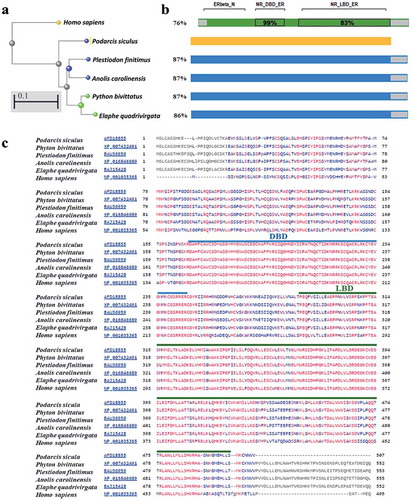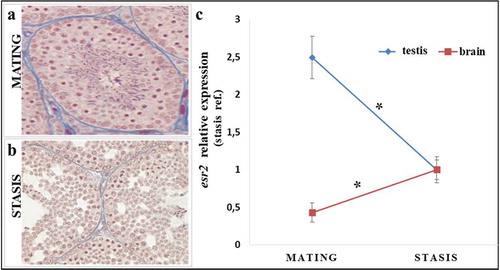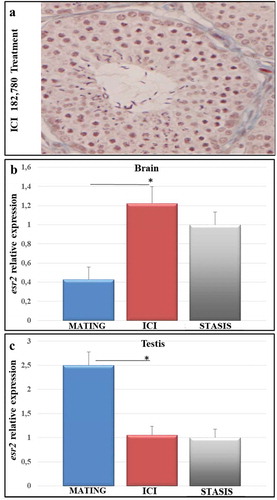Figures & data
Figure 1. (a) Phylogenetic tree of Podarcis sicula ER-BETA partial protein sequence and the four best sequence matches together with the human sequence, showing phylogenetic relationships based on multiple sequence alignment and conserved protein domains. (b) SmartBLAST identities (%) with Podarcis sicula partial sequence are indicated. The values 99% and 83% are the sequence identities of human DBD and LBD domains, respectively, vs Podarcis sicula. (c) Multiple sequence alignment of the sequences aligned in (a). The red color indicates identical residues (Cobalt). Conserved domains are indicated: DBD in blue and LBD in green.

Figure 2. Histological variation in the stages of spermatogenesis (left) and expression of the esr2 gene by qRT-PCR both in the testis and in the brain (right) in Podarcis sicula: (a) mating period: in testis tubules all spermatogenetic stages, including many sperm, are present; (b) winter stasis period: all spermatogenetic stages are present but quiescient, with only a few sperm; (c) qRT-PCR expression analysis of esr2 gene of Podarcis sicula in testis and brain samples, in the mating period (May) and winter stasis period (November) at the reference site. The relative expression of esr2 is indicated as -fold change of the mean expression relative to the winter stasis period for testis and brain samples ± SEM (*p < 0.05). Reference gene, 12S rRNA gene.

Figure 3. Histological organization of gonadal tissue and expression levels of esr2 upon treatment with the anti-estrogen ICI 182,780 during the mating period (a) Seminiferous tubules show reduced lumen and few sperm; (b,c) qRT-PCR expression analysis of esr2 gene of Podarcis sicula brain (b) and testis (c) specimens, in the mating phase (May) and upon treatment in the mating period with the anti-estrogen ICI 182,780. The relative expression of esr2 is indicated as -fold change of the mean expression relative to the stasis period ± SEM (*p < 0.05). Reference gene, 12S rRNA gene.

